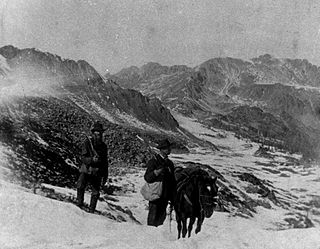
The Pike's Peak Gold Rush was the boom in gold prospecting and mining in the Pike's Peak Country of western Kansas Territory and southwestern Nebraska Territory of the United States that began in July 1858 and lasted until roughly the creation of the Colorado Territory on February 28, 1861. An estimated 100,000 gold seekers took part in one of the greatest gold rushes in North American history.

The California Gold Rush (1848–1855) was a gold rush that began on January 24, 1848, when gold was found by James W. Marshall at Sutter's Mill in Coloma, California. The news of gold brought approximately 300,000 people to California from the rest of the United States and abroad. The sudden influx of gold into the money supply reinvigorated the American economy; the sudden population increase allowed California to go rapidly to statehood in the Compromise of 1850. The Gold Rush had severe effects on Native Californians and accelerated the Native American population's decline from disease, starvation and the California genocide.

A gold rush or gold fever is a discovery of gold—sometimes accompanied by other precious metals and rare-earth minerals—that brings an onrush of miners seeking their fortune. Major gold rushes took place in the 19th century in Australia, New Zealand, Brazil, Chile, South Africa, California, the United States, and Canada while smaller gold rushes took place elsewhere.

Samuel Brannan was an American settler, businessman, journalist, and prominent Mormon who founded the California Star, the first newspaper in San Francisco, California. He is considered the first to publicize the California Gold Rush and was its first millionaire. He used the profits from his stores to buy large tracts of real estate. He helped form the first vigilance committee in San Francisco and was disfellowshiped from the Church of Jesus Christ of Latter-day Saints because of his actions within the vigilance committee. Brannan's wife divorced him and he was forced to liquidate much of his real estate to pay her one-half of their assets. He died poor and in relative obscurity.

The Territory of Colorado was an organized incorporated territory of the United States that existed from February 28, 1861, until August 1, 1876, when it was admitted to the Union as the State of Colorado.

The Ghirardelli Chocolate Company is an American confectioner, wholly owned by Swiss confectioner Lindt & Sprüngli. The company was founded by and is named after Italian chocolatier Domenico Ghirardelli, who, after working in South America, moved to California. The Ghirardelli Chocolate Company was incorporated in 1852, and is the third-oldest chocolate company in the US, after Baker's Chocolate and Whitman's.

Virginia City is a census-designated place (CDP) that is the county seat of Storey County, Nevada, and the largest community in the county. The city is a part of the Reno–Sparks Metropolitan Statistical Area.

Charlotte Mignon "Lotta" Crabtree, also known mononymously as Lotta, was an American actress, entertainer, comedian, and philanthropist.

The Otago Gold Rush was a gold rush that occurred during the 1860s in Central Otago, New Zealand. This was the country's biggest gold strike, and led to a rapid influx of foreign miners to the area – many of them veterans of other hunts for the precious metal in California and Victoria, Australia.
British Columbia gold rushes were important episodes in the history and settlement of European, Canadian and Chinese peoples in western Canada.

The Fraser Canyon Gold Rush, began in 1858 after gold was discovered on the Thompson River in British Columbia at its confluence with the Nicoamen River a few miles upstream from the Thompson's confluence with the Fraser River at present-day Lytton. The rush overtook the region around the discovery, and was centered on the Fraser Canyon from around Hope and Yale to Pavilion and Fountain, just north of Lillooet.
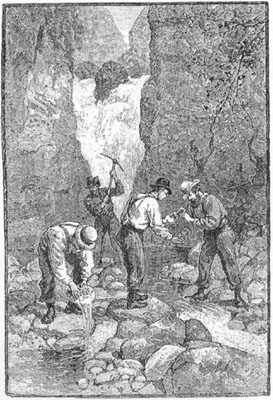
The Georgia Gold Rush was the second significant gold rush in the United States and the first in Georgia, and overshadowed the previous rush in North Carolina. It started in 1829 in present-day Lumpkin County near the county seat, Dahlonega, and soon spread through the North Georgia mountains, following the Georgia Gold Belt. By the early 1840s, gold became difficult to find. Many Georgia miners moved west when gold was found in the Sierra Nevada in 1848, starting the California Gold Rush. Since the 16th century, American Indians in Georgia told European explorers that the small amounts of gold which they possessed came from mountains of the interior. Some poorly documented accounts exist of Spanish or French mining gold in North Georgia between 1560 and 1690, but they are based on supposition and on rumors passed on by Indians. In summing up known sources, W.S. Yeates observed: "Many of these accounts and traditions seem to be quite plausible. Nevertheless, it is hardly probable that the Spaniards would have abandoned mines which were afterwards found to be quite profitable, as those in North Georgia."
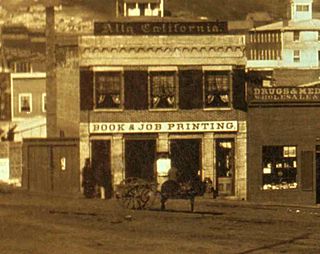
The Alta California or Daily Alta California was a 19th-century San Francisco newspaper.
"Sweet Betsy from Pike" is an American ballad about the trials of a pioneer named Betsy and her lover Ike who migrate from Pike County to California. This Gold Rush-era song, with lyrics written by John A. Stone before 1858, was collected and published in Carl Sandburg's 1927 American Songbag. It was recorded by Burl Ives on February 11, 1941 for his debut album Okeh Presents the Wayfaring Stranger.

Rancho San Francisco was a land grant in present-day northwestern Los Angeles County and eastern Ventura County, California. It was a grant of 48,612 acres (19,673 ha) by Governor Juan B. Alvarado to Antonio del Valle, a Mexican army officer, in recognition for his service to Alta California. It is not related to the city of San Francisco.

Alonzo Delano, who went by the pen name "Old Block", was an American humorist, pioneer town city father, and a California Gold Rush Forty-niner. Delano's sketches of gold rush camp life rivaled Bret Harte and Mark Twain in popularity.
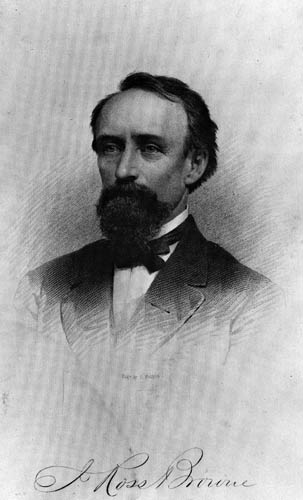
John Ross Browne, often called J. Ross Browne, date of birth sometimes given as 1817, was an Irish-born American traveler, artist, writer and government agent. In the late 1970s, Ralston Purina opened a chain of seafood restaurants named after Browne, called J Ross Browne's Whaling Station.
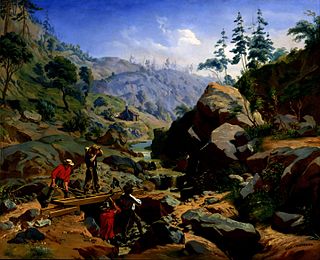
Frederick August Wenderoth or F. A. Wenderoth was a German-born American painter and photographer. Born and educated in Cassel, where he first learned to paint from his father, he established a lifelong friendship with Charles Christian Nahl at school. During the 1840s period of political upheaval in Hesse, he moved to Paris, where he was joined by Nahl and his half-brother Arthur Nahl.
Girls of the Golden West is an opera in two acts with music by John Adams and a libretto by Peter Sellars. The San Francisco Opera commissioned the work jointly with Dallas Opera, the Dutch National Opera and Teatro La Fenice in Venice. The opera was premiered in San Francisco on November 21, 2017. The running time is 160 minutes.
John Boessenecker is an American historian and author, and a lawyer specializing in trust and estate litigation. He is based in San Francisco, California.

















